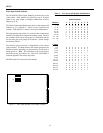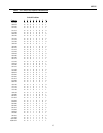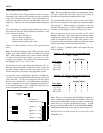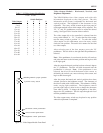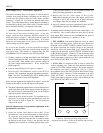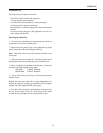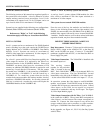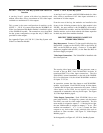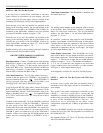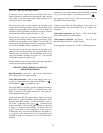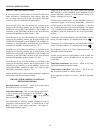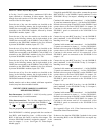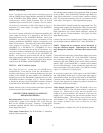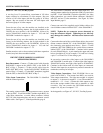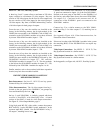
LEVEL 1 - 448 X 16, Two Bay System
A two bay, Level 1 system allows a maximum of 448 video
inputs switched to a maximum 16 video outputs. Bay one
consists of the first 256 video inputs. Bay two consists of the
remaining 192 video inputs and four video output modules.
From the rear of bay one, the modules are installed at the
factory in the following manner; the far right module is the
2010PS, the next module is the 2010DB-11 with 16 BNCs for
connection to the 2024VOM-1 modules in bay two, followed
by sixteen 2016AVIM-1 modules for inputs 1 - 256.
From the rear of bay two, the modules are installed at the
factory in the following manner; the far right module is the
2010PS, the next module is the 2010DB-00, followed by
twelve 2016AVIM-1 modules for inputs 257 - 448, and four
2024VOM-1 modules for outputs 1 - 16.
Smaller matrices, such as those ordered with future expansion
in mind, may have fewer modules installed.
IDENTIFY THESE MODULES CAREFULLY
BEFORE PROCEEDING.
Data Interconnect: Connect a 75-ohm coaxial cable from the
DATALINE-1 output on the AD1024 CPU to the DATA IN
BNC of Bay 1. Connect a 75-ohm coaxial cable from the
DATA OUT BNC of bay 1 to the DATA IN BNC 2010PS rear
panel of bay 2. Connect a 75 ohm BNC terminator (supplied
with the CPU) to the Data Out BNC of Bay 2.
Video Interconnections: The 16 video outputs from bay 1,
located on the rear panel of the 2010DB-11, are grouped by
fours and identified by the icon . Each 2024VOM-1 is
similarly grouped with three sections of four BNCs, with
identifying icons. See Figure 5, Data Buffer, page 4.
Using high grade RG-59U video cables, connect the topmost
BNC from bay 1 on the 2010DB-11 panel, numbered 1, to the
topmost input BNC, labeled 1 on the 2024VOM-1 in bay 2, for
output 1, matching icon to icon . See Appendix Figure
A18, Video Interconnections, for illustration of these
connections.
Continue in this manner until 1-4 of the 2010DB-11 panel are
connected to inputs 1-4 of the first 2024VOM-1. Proceed to
the next group of four BNCs on the 2010DB-11 panel.
Connect these four to the second 2024VOM-1 for outputs 5-8.
Continue in this manner until all 16 connections of the
2010DB-11 panel are connected to all of the 2024VOM-1
modules. If there are less than four 2024VOM modules in the
system, leave the remaining BNCs on 2010DB-11 of bay 1
open.
Video Input Connections: The 2016AVIM is identified with
the camera input icon.
The starting camera number for the particular VIM is located
at the top BNC. Each 2016AVIM-1 includes 16 terminated
BNCs for video input connections. The first 2016AVIM
module is for video inputs 1 - 16, the second VIM module is
for inputs 17 - 32, etc.
In succession, connect the video inputs to each 2016AVIM-1
module, top to bottom. Each VIM will accept 16 video inputs.
Continue until all inputs are connected to the system. Unused
video inputs, on the VIM, do not require any external
connection or termination, and may be left open. See Figure
16, Video Input Modules, page 8.
Video Output Connections: Each 2024VOM-1 has a rear
panel with 16 BNCs, only the bottom four BNCs are used for
video output connections. The left most module is assigned to
outputs 1 - 4. Moving left to right, the next VOM module is
assigned to outputs 5 - 8, etc. (The modules are numbered 1 -
4, 5 - 8, etc.) Connect the video outputs to any device that
accepts standard video such as monitors or video recorders.
See Figure 21, Video Output Module, page 9.
In the Appendix, see Figure A3, 448 X 16, Two Bay System.
LEVEL 1 - 448 X 16, Two Bay System with Video Loss
Detection
A two bay, Level 1 system, with video loss detection, allows a
maximum of 448 video inputs switched to a maximum of 15
video outputs.
This system is the same configuration of modules as the
LEVEL 1 - 448 X 16 system above, except that the
2010DBVL-11 module is installed in place of the 2010DB-11
module in bay one and the 2010DBVL-00 module is installed
in place of the 2010DB-00 module in bay two. The
connections are as described for the above system
configuration, except that only 15 BNCs are provided for video
outputs.
Since two 2010DBVL modules are used, this configuration
requires the use of the 1981 Port Expander for connection to
the ADAD1024 CPU.
See Appendix Figure A21, 256 X 15, Two Bay System with
Video Loss Detection Module.
SYSTEM CONFIGURATIONS
22



